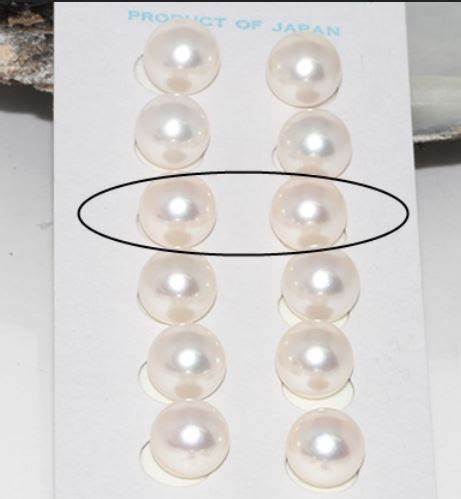Introducing Akoya Pearls
Akoya pearls are pearls from Japanese pearl farming. The Japanese are indeed, the people who first discovered the possibility of growing oyster pearls in the 1990s.
Previously pearls were very rare. Their value was therefore only greater. Only a few princes could afford the luxury of employing divers to look for pearls at the bottom of the sea and near the coast. A lucky few could also find pearls by chance.
Thus, in the 1990s Japanese developed a technique to grow these pearls in their oysters. This technique has been disseminated around the world and is now used by many islands to produce a decent income. Indeed, the pearl trade is often a large part of the income of most of the Globe Islands. These people were thus able to develop an unrivalled expertise in pearl cultivation, pearl farming.
The Japanese who discovered and developed this method of cultivation began the production of pearls from Japan. These are the Akoya pearls. These are not the rarest pearls, far from it. However these beads still have great value and are of impeccable quality. These two factors explain their number in the different European and American pearl markets, the two largest bead applicants.
Today Japan is no longer the largest producer of pearls. It has indeed been overtaken by the island of Tahiti which cultivates in particular its beautiful Tahitian pearls
Akoya Pearls are made from Pinctada Fucata Martensii oysters that have a diameter of 7 to 8 centimetres. This diameter is small enough for an oyster growing pearls but allows to give a better layer of mother-of-pearl and greater resistance to the pearl.
To grow these pearls, the grower will introduce an irritating object called the graft into one of these oysters. The oyster goes to defend itself surround the object with a layer of mother-of-pearl. This layer of mother-of-pearl more or less thick and shiny gives all the value to what will become the pearl.
After cleaning and drying for several hours, the Akoya Pearl is ready to be used for necklaces, bracelets. This very long drying time ensures better shine.
Akoya Pearl Features
Pearls are fairly uniform beads in diameter. The degree of variation in diameter very rarely exceeds 10%. They are therefore very beautiful and very pure for pearls grown in astronomical quantities.
The Akoya pearl has a very high growing time. This is a minimum of 12 months and can last up to 24 months. Because the oyster is smaller, this high growing time helps to strengthen the resistance of the mother-of-pearl and increase its shine. Indeed, pearls are like good wine. The more time, the more divine it is.
In the end, the beads measure enter 2.5 and 10.5 millimeters. They are therefore very small for cultured pearls compared to the Black Pearls of Tahiti for example. In fact, the latter measure on average 11 millimetres. Again, this set size offset by an exceptional quality of mother-of-pearl. The Akoya Pearl becomes rare when its diameter exceeds 9 millimeters.
For the shape, Akoya pearls can be round, semi-round or baroque. The most sought-after pearls are round pearls. However, some baroque beads can have a very high value when the shape is particularly harmonious and interesting. The baroque term for the shape of a pearl means that there is little or no symmetry and that it is difficult to measure the diameter exactly.
Being very small, the Akoya pearl is often used with other beads such as on a pearl necklace or a bracelet with different beads.
Different standards or criteria based on shape, colour, quality of mother-of-pearl, size and degree of brilliance help define the quality of an Akoya pearl. In particular, a term is used to define the perfect Akoya pearls. This term is Hanadama which means "spherical flower." These perfect pearls are extremely rare, very expensive but are beautiful. Indeed, they are perfectly round, they have a bright shine, their mother-of-pearl is of a superior quality and their surface has absolutely no defects visible to the naked eye.
Other ranks ranging from AAA for the best beads to A for the worst use these different criteria.
The Akoya Pearl has a very soft and often perfectly uniform color, which greatly facilitates its combination with other pearls. Their color is often white or cream. To this color is often added a reflection of pink, even yellow or green. The greater the luster and shine, the higher and more beautiful the reflection.

Searches associated with Akoya Pearls
Akoya aaa Pearls, Japanese Akoya Pearls, Akoya Pearl Jewelry, Pearl Pearl, Pearl Culture, Japanese Pearls, Akoya Culture Pearls, Akoya Pearls, Diamond Pearl Jewelry, Pearls, Pearls, Pearl, Akoya Pearl Price
Although today these pearls are still called Akoya Pearls from Japan, a large majority of these pearls are grown in China. Indeed, China has more and more pearl farms. THE labor being much cheaper than in Japan the cultivation of pearls is very expensive for the producers of Akoya Pearls. Often, the pearls are grown for many months in China and sent to Japan for cleaning. Indeed, the Japanese still have an impressive know-how in pearl culture. This know-how tends to be lost by relocating to China, however farms still remain in Japan. These pearls grown in Japan are even more expensive but are of legendary quality. Indeed, the Japanese are very precise and very meticulous. They have methods to produce the best Akoya Pearls in the world. These pearls are now exported all over the world. It is common to see the inscription "Made in Japan" on Akoya pearl packaging. However often the pearl is grown in China and then cleaned in Japan where this phrase is inscribed.
Our Akoya Pearls have been selected by specialists on thousands of very good quality pearls.
